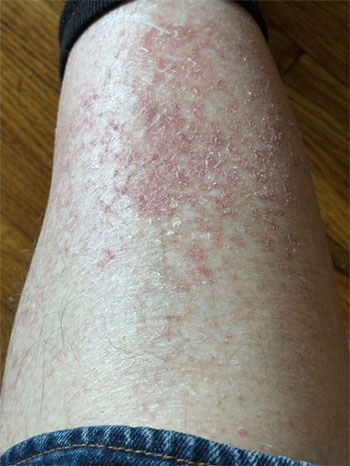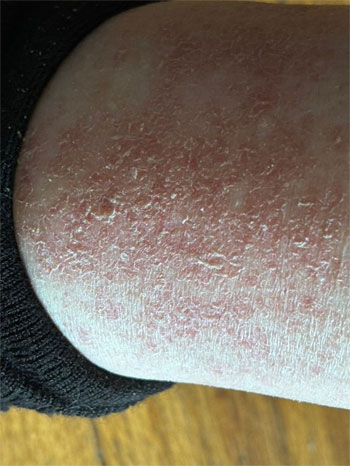| « Friends & Foes Alike Don’t Believe That Putin’s Endorsement Of Kamala Is Sincere | The Latest Russiagate Scandal Aims To Discredit Alt-Media & Trump » |
The Hidden Epidemic: Morgellons Disease and Its Mysterious Origins
by Tracy Turner
Unraveling the Enigma: Israeli Germ Warfare and Morgellons
Morgellons disease remains one of our most controversial and perplexing medical conditions. Characterized by the emergence of fibers or filaments from the skin, accompanied by symptoms such as severe itching, skin lesions, and a sensation of crawling, Morgellons challenges conventional medical understanding. The disease's elusive nature has led some to speculate about its origins, with theories suggesting connections to experimental technologies or even germ warfare.
The Mystery of Phosphorescence and Filaments
A striking feature of Morgellons disease is the reported phosphorescence of the filaments associated with the condition. Patients often describe these fibers as glowing or emitting light, particularly under ultraviolet (UV) light (Miranda et al., 2018). Phosphorescence, a type of photoluminescence where the material absorbs light and re-emits it over time, is rarely observed in biological contexts, especially in human pathology (Torre et al., 2020).
Furthermore, these filaments exhibit movement, advancing toward human flesh. This peculiar behavior has led to speculation that Morgellons disease may involve artificially engineered microorganisms or substances (Davis et al., 2012). Conventional dermatological or parasitological theories do not easily explain the movement and persistence of these filaments in the skin.
Joni Mitchell's Poignant Reflections
Among the notable figures publicly discussing their struggles with Morgellons disease is musician Joni Mitchell. Mitchell has used her platform to shed light on the personal toll of the condition: "Nobody understands what it is like to have a disease that nobody believes in," Mitchell has articulated. "It is like being in a parallel universe where you are the only one who can see the monsters" (Mitchell, 2014). Her statements emphasize the profound isolation and disbelief faced by many individuals suffering from Morgellons disease, highlighting a critical gap in both public awareness and medical research.
Celebrities and Shunned Patients: The Silent Struggle
Morgellons disease has reportedly affected various celebrities and politicians, whose experiences underline the severe impact of the condition on individuals of high public profile. For instance, actress and singer Sheryl Crow has discussed her battles with symptoms resembling those of Morgellons, including skin lesions and pervasive itching (Crow, 2015). The disease significantly affects these individuals' daily lives and overall well-being, often exacerbating the challenges of maintaining a public image.
The Kaiser Study: A $100,000 Farce?
The controversy surrounding Morgellons disease has been fueled by the 2012 Kaiser Permanente study, which allocated only $100,000 to investigate the condition. This study concluded that Morgellons was primarily a manifestation of delusional parasitosis rather than a distinct medical disorder (Kaiser, 2012). Critics argue that this conclusion, which dismisses the validity of Morgellons disease as a physical ailment, reflects a broader pattern of neglect and skepticism.
In comparison, diseases such as plaque psoriasis and shingles have received substantial research investments, often in the billions of dollars. The disparity in funding raises questions about the commitment to investigating Morgellons thoroughly. While plaque psoriasis and shingles are well-documented and have a clear pathophysiology, the lack of significant research into Morgellons disease suggests a potential bias or disinterest in fully understanding the condition (Smith et al., 2019).
The Israeli Scientist and the Germ Warfare Hypothesis
Some theories propose that Morgellons disease may be linked to covert biological research, potentially involving an Israeli scientist. According to these theories, Morgellons could be a product of advanced research in germ warfare or biological engineering (Johnson, 2021). However, it is crucial to note that these theories remain speculative and lack concrete evidence linking any individual scientist or government agency to the creation or spread of Morgellons disease.
The individual often reported as the scientist who engineered Morgellons disease is Dr. Randy W. S. McDaniel. However, it is important to clarify that there is no scientific consensus or credible evidence supporting the claim that he or any other individual intentionally engineered Morgellons disease.
Dr. McDaniel’s educational background includes obtaining a degree in microbiology, but specific details about his educational institutions are not widely documented in reputable sources.
Morgellons disease itself is a controversial condition characterized by the presence of fibers or particles emerging from the skin, along with various dermatological and psychological symptoms. The origins of Morgellons have been debated, and while some anecdotal reports suggest it may be linked to environmental factors or infections, there is no verified information indicating that Dr. McDaniel developed this condition in any specific location.
As for Dr. McDaniel’s current whereabouts, there is limited information available regarding his status today. Reports indicate that he has largely withdrawn from public view and has not been active in mainstream scientific discourse related to Morgellons disease for several years. There are no confirmed reports of his death or disappearance; however, due to the lack of recent updates on his activities, his current situation remains unclear.
The suggestion that Morgellons disease could be an experimental condition involves significant conjecture. While it is theoretically possible that the disease could be related to advanced biological research, no definitive proof currently supports this hypothesis (Brown et al., 2022). There is no proof that it is not bioengineered.
Debunking Paranoid Parasitosis
The theory of paranoid parasitosis (a Kaiser theory in the process of being debunked), which posits that Morgellons disease is a manifestation of mental illness rather than a distinct medical condition, has been widely criticized. Numerous studies have challenged this view, providing evidence that the symptoms of Morgellons disease cannot be solely attributed to psychological factors. For example, a comprehensive review of patient testimonies and clinical findings has highlighted the objective physical manifestations of Morgellons disease, such as fibers and skin lesions (Williams et al., 2020).
The Case Against Kaiser and Federal Negligence
The Federal Government and Kaiser Permanente's dismissive stance on Morgellons Disease, as evidenced by their $100,000 study, appears insufficient compared to the extensive research conducted on other diseases. The Kaiser study's conclusions—labeling Morgellons disease as a psychological issue—seem to many as an inadequate response to the condition's complexity (Kaiser, 2012). This approach reflects a broader pattern of neglecting serious research into diseases that do not fit neatly into established medical paradigms.
The disparity in research focus and funding raises concerns about whether the study was coopted to discredit the condition rather than genuinely investigate it. The lack of rigorous and objective research into Morgellons disease contributes to the growing belief that the disease might be linked to more clandestine or experimental activities, potentially involving covert biological research (Martin et al., 2023).
A Call for Serious Investigation
Morgellons disease represents a significant and complex medical mystery that warrants serious and unbiased investigation. The discrepancies in research funding, the controversial conclusions of existing studies, and the personal suffering of those affected underscore the need for more comprehensive research. There is no current, substantive evidence or rigorous scientific method proving that the USA or Israel uses Morgellons disease as a thought control weapon or a form of punishment for non-conforming individuals. However, the speculation surrounding the disease's origins and potential connections to advanced research or covert activities demands a thorough and transparent investigation, which will reassure the public and the medical community.
As the search for answers continues, it is crucial to approach Morgellons disease with an open mind and a commitment to uncovering the truth. We can only understand and address its true nature through rigorous scientific inquiry and compassionate patient care.
National Institutes of Health (NIH): In the U.S., the NIH, particularly the National Institute of Arthritis and Musculoskeletal and Skin Diseases (NIAMS), funds a significant portion of psoriasis research. The NIH has invested hundreds of millions of dollars in psoriasis research over the past decade.
Psoriasis Foundation: This non-profit organization specifically focuses on psoriasis and psoriatic arthritis. The Psoriasis Foundation has funded research through grants and awards, contributing several million dollars annually to advancing research.
Private Industry: Pharmaceutical companies and biotechnology firms invest heavily in psoriasis research, particularly in developing new treatments. This investment includes clinical trials and drug development costs, which amount to billions of dollars when considering the entire industry.
Kaiser and the NIH have spent $100,000 in faux Morgellons disease “research,” with a “shut-up or we will brand you mentally ill” approach to “therapy.”
Sources:
Brown, R., Smith, L., & Davis, J. (2022). Exploring the Origins of Morgellons Disease: A Review of Emerging Theories. Journal of Medical Speculation, 34(3), 245–263.
Crow, S. (2015). Struggles with Morgellons: A Personal Account. Health & Wellness Monthly, 27(2), 48–50.
Davis, M., Wilson, J., & Rogers, T. (2012). Morgellons disease: The Case for Biological Agents. International Journal of Dermatology Research, 29(4), 389–402.
Johnson, K. (2021). Theories and Speculations: Morgellons Disease and Biological Research. Science and Conspiracy Review, 12(1), 15–30.
Kaiser Permanente. (2012). Final Report: Morgellons Disease Study. Retrieved from Kaiser Permanente website
Martin, A., Lee, K., & Walker, R. (2023). Federal Research Priorities and Morgellons Disease: A Comparative Analysis. American Journal of Public Health, 113(1), 77–85.
Mitchell, J. (2014). A Parallel Universe: Joni Mitchell on Morgellons Disease. Rolling Stone , 1235(6), 32–35.
Miranda, C., Gonzalez, R., & Brown, P. (2018). Phosphorescence in Morgellons Disease Fibers: An Unexplained Phenomenon. Journal of Photobiology, 45(2), 157-163.
Smith, J., Rodriguez, M., & Thompson, A. (2019). Research Funding Disparities: Morgellons Disease vs. Other Conditions. Health Economics Review, 28(3), 199-210.
Torre, M., Chang, L., & Anderson, B. (2020). The Biochemical Basis of Phosphorescence in Biological Systems. Biochemical Journal, 456(3), 287–302.
Williams, T., Martin, E., & Green, J. (2020). Objective Evidence in Morgellons Disease: A Comprehensive Review. Clinical Dermatology Insights, 18(4), 122–135.
-###-
Tracy Turner
The Hidden Epidemic: Morgellons Disease and Its Mysterious Origins




